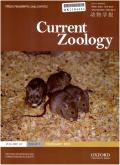Intra-tooth stable isotope analysis reveals seasonal dietary variability and niche partitioning among bushpigs/red river hogs and warthogs
IF 2
2区 生物学
Q2 ZOOLOGY
引用次数: 0
Abstract
How animals respond to seasonal resource availability has profound implications for their dietary flexibility and realized ecological niches. We sought to understand seasonal dietary niche partitioning in extant African suids using intra-tooth stable isotope analysis of enamel. We collected enamel samples from canines of red river hogs/bushpigs (Potamochoerus spp.) and third molars of warthogs (Phacochoerus spp.) in three different regions of central and eastern Africa. We analyzed multiple samples from each tooth and used variations in stable carbon and oxygen isotope ratios (δ13C and δ18O) and covariances between them to infer seasonal dietary changes. We found that most Phacochoerus display C4-dominated diets, while most Potamochoerus display C3-dominated diets. Phacochoerus and Potamochoerus that co-occur in the same region display no overlap in intra-tooth δ13C, which suggests dietary niche partitioning. They also show diverging δ13C values as the dry seasons progress and converging δ13C values during the peak of the rainy seasons, which suggests a greater dietary niche separation during the dry seasons when resources are scarce than during the rainy season. We found statistically significant cross-correlations between intra-tooth δ13C and δ18O in most specimens. We also observed a temporal lag between δ13C and δ18O in some specimens. This study demonstrates that intra-tooth stable isotope analysis is a promising approach to investigate seasonal dietary niche variation. However, large inter-individual variations in δ18O at certain localities can be challenging to interpret. Future studies that expand the intra-tooth stable isotope surveys or include controlled feeding experiments will improve its application in ecological studies.齿内稳定同位素分析揭示了丛林猪/红河猪和疣猪的季节性膳食变化和生态位分区
动物如何应对季节性资源供应对其膳食灵活性和实现生态位有着深远的影响。我们试图利用珐琅质的齿内稳定同位素分析来了解现存非洲麂类的季节性食物位分配。我们在非洲中部和东部的三个不同地区采集了红河猪(Potamochoerus spp.)的犬齿和疣猪(Phacochoerus spp.)的第三臼齿的珐琅质样本。我们对每颗牙齿的多个样本进行了分析,并利用稳定碳和氧同位素比值(δ13C 和 δ18O)的变化以及它们之间的协变来推断季节性饮食变化。我们发现,大多数法氏巨蜥以 C4 为主,而大多数波达莫巨蜥以 C3 为主。共同出现在同一地区的法古长尾蜥和波塔莫长尾蜥在牙齿内δ13C上没有重叠,这表明它们的食物生态位是分区的。随着旱季的到来,它们的δ13C值也出现了分化,而在雨季高峰期,它们的δ13C值则趋于一致,这表明在资源稀缺的旱季,它们的食物生态位分离程度要高于雨季。我们发现,在大多数标本中,齿内δ13C和δ18O之间存在统计学意义上的交叉相关。我们还观察到一些标本的δ13C和δ18O之间存在时滞。这项研究表明,牙内稳定同位素分析是研究季节性食物生态位变化的一种很有前景的方法。然而,在某些地方,δ18O的个体间差异很大,解释起来很困难。未来的研究若能扩大牙内稳定同位素调查范围或纳入受控进食实验,将提高其在生态研究中的应用。
本文章由计算机程序翻译,如有差异,请以英文原文为准。
求助全文
约1分钟内获得全文
求助全文
来源期刊

Current Zoology
Agricultural and Biological Sciences-Animal Science and Zoology
CiteScore
3.20
自引率
9.10%
发文量
111
审稿时长
6 weeks
期刊介绍:
About the Journal
Current Zoology (formerly Acta Zoologica Sinica, founded in 1935) is an open access, bimonthly, peer-reviewed international journal of zoology. It publishes review articles and research papers in the fields of ecology, evolution and behaviour.
Current Zoology is sponsored by Institute of Zoology, Chinese Academy of Sciences, along with the China Zoological Society.
 求助内容:
求助内容: 应助结果提醒方式:
应助结果提醒方式:


